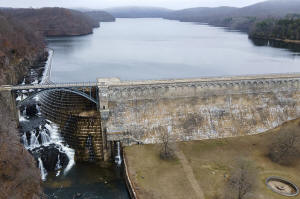NYC will eventually have to abandon part of its water supply if it keeps
getting saltier
[March 22, 2025]
By MICHAEL HILL
The suburban reservoirs that supply 10% of New York City's vaunted
drinking water are getting saltier due to decades of road salt being
spread near the system — and they will eventually have to be abandoned
if nothing is done to reverse the trend, city officials warn.
The plug wouldn't have to be pulled until early next century, according
to a new study. But the soaring saltiness could eventually affect the
famous taste of the Big Apple’s water, which is sometimes called the
champagne of tap water, and poses a challenge to managers of a system
that serves more than 9 million people.
“The conclusion of this study is that if we don’t change our ways, in
2100 the Croton Water System becomes a nice recreational facility, but
it ceases to be a water supply,” Rohit Aggarwala, the city’s
environmental protection commissioner, said in an interview with The
Associated Press. “And that will directly impact everybody who drinks
New York City water.”
The Croton system dates back to 1842 — when the first Croton Aqueduct
began delivering water to a reservoir in what is now Manhattan’s Central
Park — and is now comprised of 12 reservoirs and three controlled lakes
north of the city.
The report found the concentration of chlorides — an indicator of
salinization — tripled from 1987 to 2019 in the system's main reservoir,
which is about 20 miles (32 kilometers) north of the city line.
Concentrations are on track to exceed the state’s maximum contaminant
level for chloride by 2108.

The report found salinity increases across the sprawling system of city
reservoirs in upstate New York. However, the problem is far less of an
issue in the Delaware and Catskill watersheds west of the Hudson River,
which supply about 90% of the city’s water. That’s likely because
there’s far less development in those watersheds.
Road salt is considered a main driver of the increase, along with sewage
treatment plant discharges and water softeners. Millions of tons of rock
salt is spread on U.S. roads each winter as a cheap and effective way to
reduce accidents.

[to top of second column]
|

The New Croton Dam and the New Croton Reservoir that supplies part
of New York City's drinking water is seen in Cortlandt, N.Y., on
Thursday, March 20, 2025. (AP Photo/Ted Shaffrey)

“It's really a problem across the country in areas with a lot of
snow,” said Shannon Roback, science director for the environmental
group Riverkeeper. “We’ve seen rising levels of salt in water in the
Northeast, in the Midwest and in most places that use road salt.”
Roback noted that high salt levels in drinking water pose a host of
environmental concerns and can be harmful to people on low-sodium
diets.
Aggarwala said the city has a few options.
Salt can be removed from water supplies through reverse osmosis
systems, though the technology is expensive and requires a lot of
energy. The city also could mix Croton water with less salty water
from its other two watersheds. But the commissioner said that would
not be a solution for the more than a dozen municipalities north of
New York City that draw water from the Croton system.
City officials believe reducing the use of road salt locally is the
most sensible option. That could involve persuading state and local
road crews to use alternatives to salt, or sensors on plows to gauge
road surface temperatures, or shutting off the applicators when
plows make U-turns or K turns.
State Sen. Pete Harckham, who represents the area, called the new
report alarming, but not surprising given a number of community
wells taken offline due to high chloride levels. The Democrat is
sponsoring bills that would address the road salt issue, including
one that would study the issue in the Croton watershed.
“State agencies, local governments, everyone needs to come together
on this,” he said, “because this is a real challenge.”
All contents © copyright 2025 Associated Press. All rights reserved |